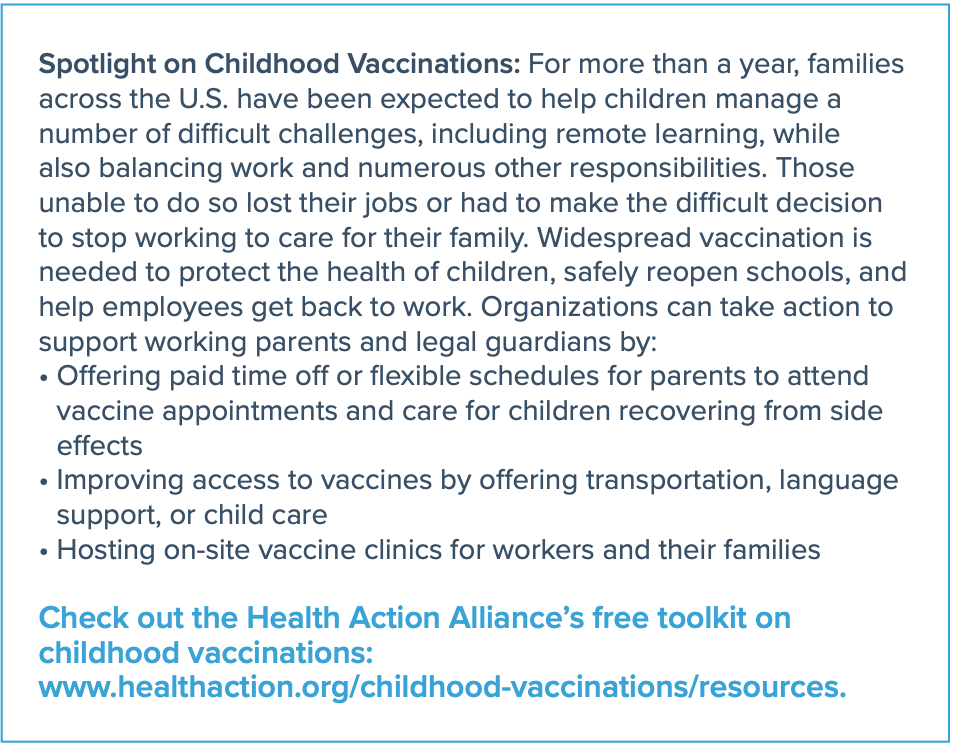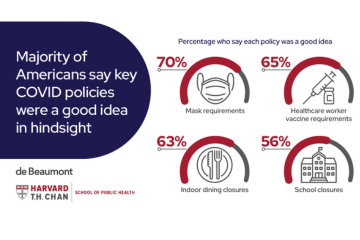The pandemic has crystallized the inextricable link between America’s community health and economic wellbeing – and made us painfully aware that our public health infrastructure is at a dangerous tipping point. Decades of underinvestment and inadequate support for public health across sectors has left our nation struggling to address COVID-19. Without healthy and safe places to live, work, and play, there simply can be no pathway to economic or social prosperity. But even before the pandemic, employee health, safety, and well-being were bottom line concerns for businesses. Poor worker health and illness-related absences cost U.S. employers an estimated $575 billion and 1.5 billion days of lost productivity in 2019.1
While many businesses create programs and policies to improve the health of workers, they fail to address the broader community health conditions where workers live, work, and play. Upwards of 70 percent of an individual’s health status is driven by the social and environmental factors that surround them. As the nation recovers from the pandemic, community health, not just employee health, should be a strategic consideration for every employer. This starts with supporting families of employees and extends to the local communities in which we operate.
We offer seven ways businesses can align with public health for bold action and innovation to address employee and community health needs.2
1) “Put out the fire” of COVID-19 by following the advice of credible experts.
- Empower a Chief Medical Officer or Chief Public Health Officer to prioritize public health and safety when designing employee vaccination policies and workplace safety protocols.
- Ensure that trusted public health recommendations are reflected in employee newsletters, on-site signage, town hall meetings, and advertising.
2) Improve the health and well-being of employees.
- Apply available tools and resources for advancing workplace health, safety, and well-being.
- Champion critical public health policies such as promoting earned sick leave to create a more resilient workforce.
- Promote longer-term strategies (e.g., paid parental leave, access to vaccinations, flexible work schedules, livable wages).
3) Promote healthy communities.
- Consider how your organization can address the root causes of poor health and inequities in your communities, such as access to affordable housing, good quality air and water, universal pre-kindergarten, and healthy food procurement.
4) Become a “force multiplier” by leveraging your expertise to collaborate with and support local and state public health departments.
- Attend one another’s meetings to increase information sharing and leverage resources from a wider public health network.
- Expand natural disaster preparedness plans to include immediate health crises (e.g., COVID-19) as well as longer term public health concerns.
5) Actively facilitate public-private partnerships in the community.
- Advocate for a Chief Public Health Strategy liaison between business and public health.
- Convene round tables and think tanks sponsored by the business community.
6) Advocate for development of accountability dashboards that track and monitor progress towards achieving key economic and public health outcomes.
- Local chambers of commerce and public health agencies can reference these dashboards as monitoring tools for community initiatives.
7) Advocate for rebuilding and expansion of a national public health workforce supported by a modern information technology infrastructure.
Business leaders have extraordinary influence to bring about change at the local level. No matter where your organization is starting from, the above recommendations can help advance your efforts to improve employee health, safety, and well-being with a spillover effect on customer satisfaction. By working across sectors, businesses can help build partnerships and prioritize investments that improve community health, inside and outside the workplace. They can also enable their employees to care for those around them. Over the long run, a healthier community creates a stronger economic engine to enhance residents’ health, well-being, and prosperity.
References
1. Jaspen, Bruce. “Poor Worker Health Costs U.S. Employers $575 Billion A Year.” Forbes. Dec. 8, 2020. https://www.forbes.com/sites/brucejapsen/2020/12/08/poor-worker-health-costs-us-employers-575-billion-a-year/?sh=1287d18817.
2. The de Beaumont Foundation (2021). Seven Ways Businesses Can Align with Public Health for Bold Action and Innovation. Prepared by The Institute for Health and Productivity Studies at the Johns Hopkins Bloomberg School of Public Health and the de Beaumont Foundation. https://debeaumont.org/businesspublichealth/





